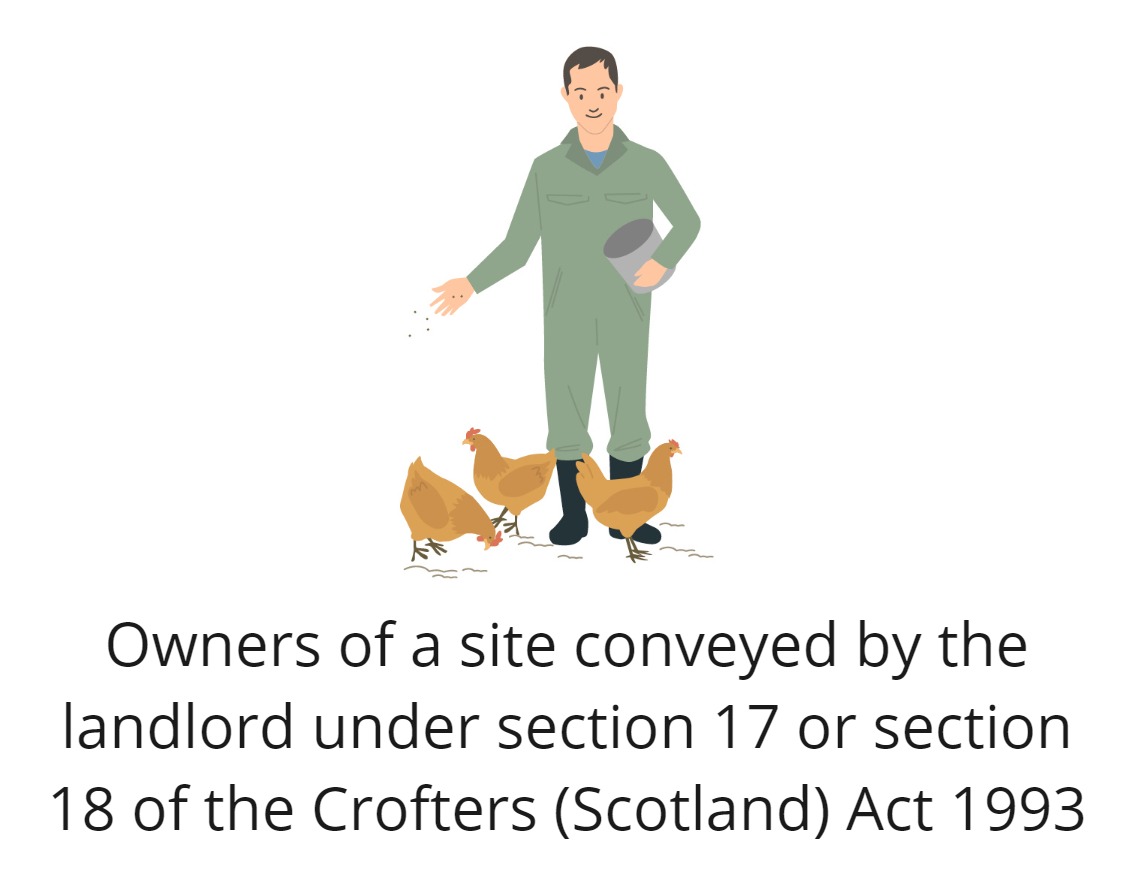
and promotes the interests of crofting in Scotland
to secure the future of crofting.
Decrofting S17 or 18 Feu
Decrofting removes land from a croft so crofting laws no longer applies. Between 1955 and 1976 in certain circumstances crofters could acquire ownership of their dwelling house and garden ground from their landlord. This was done with a ‘conveyance in feu’ under section 17 and section 18 of the Crofters (Scotland) Act 1955.
Section 17 Feus were granted to absentee crofters, following action by the Commission to terminate (end) heir croft tenancy.
Section 18 Feus were granted to ‘aged crofters' (no longer able to work their croft), who gave up (renounced) their croft tenancy.
Section 17 and 18 Feus were discontinued when the Crofting Reform (Scotland) Act came into effect on 10th June 1976. However, the land to which they relate continues to be held in crofting tenure and is subject to the Crofting Acts until a decrofting direction has been granted by the Crofting Commission.
The land referred to in the Section 17 or Section 18 Feu which was granted remains subject to the Crofting Acts until such time as it is decrofted.
Who can apply?

Owners of a site conveyed by the landlord under section 17 or section 18 of the Crofters (Scotland) Act 1993. The original Title granted by the landlord will normally include a reference to the area being conveyed under section 17 or section 18 of the 1955 Act.
What you need to apply:

- A completed Decrofting - S17 or S18 Feu application form.
- We require to see a copy of the original Title and Title map granted for the dwelling house and garden ground under section 17 or section 18 of the 1955 Act.
- If you become the owner of the land after the original Title was granted, you will also need to provide a copy of your Title Deeds or Land Certificate.
- A Registers of Scotland First Registration application, which should ideally be submitted at the same time as your decrofting application.
Application form
It is important to read the guidance notes fully before and as you complete the application form. These notes will tell you what information you need to include in your application and what other documents you need to submit.
To access the application forms and associated guidance, please use our form finder.
Here is a summary of the key points:
- Read the guidance notes before and as you fill out your decrofting S17 or s18 Feu application.
- You can submit your application online or by post
Registers of Scotland Application
Registers of Scotland (RoS) hold the Crofting Register, which is a map based register of croft and common grazings land. If you are completing a Decrofting – S17 or S18 Feu application you will need to register your croft with Registers of Scotland for the first time You need to submit a First Registration (FORM A) application. In this application you will need to provide a map of your croft boundary, which is the area of land referred to in the S17 or S18 Feu originally granted to the absentee or aged crofter by the landlord.
For details of how to prepare a map of your croft and the correct form to use, please refer to the Registers of Scotland website.
You should submit your First Registration (FORM A) application to the Crofting Commission by post. You need to pay a fee of £90 when you submit your application. This can be paid by a cheque made out to the Crofting Commission, or by bank transfer. The Crofting Commission will check and process your application and will forward it to Registers of Scotland. Your decrofting application will be processed more quickly if you send this to us at the same time as you apply to decroft. The registration application must be submitted within 6 months of your decrofting application being received, or your Decrofting – S17 or S18 Feu application cannot be processed by the Crofting Commission and you will need to re-apply.
Here is a summary of the key points
• You need to register your croft land with the Registers of Scotland.• You need to pay a fee of £90 when you submit your Registers of Scotland application.
• The Crofting Commission will process and forward your registration application to Registers of Scotland.
Once the Crofting Commission have received your completed decrofting application we will check to make sure that you have filled out the correct form, that the area you have applied to decroft matches the area that was feued under section 17 or section 18 of the 1955 Act, and have submitted all of the required information. If you have not submitted everything correctly, you will be made aware and will have 28 days to submit the information requested.
You will need to also apply to register your croft on the Registers of Scotland Crofting Register because of your decrofting application. The Crofting Commission will not begin to process your decrofting application until your First Registration (FORM A) application is submitted.
If your decrofting application is completed correctly and we have all the information we need, the Crofting Commission will try to make a decision within 16 weeks. However, your application cannot be decided until your croft is registered with the Registers of Scotland.
Here is a summary of the key points:
- The Crofting Commission will check your decrofting and registration applications to make sure they are complete and correct.
- The Crofting Commission cannot make a decision on your decrofting application if your croft is not registered with the Registers of Scotland.
Once the croft is registered on the Registers of Scotland Crofting Register, provided you have supplied the Crofting Commission will all of the information required to consider your decrofting application, a document called a ‘Decrofting Direction’ will be prepared and a copy will be sent to you by recorded delivery post.
IThe Crofting Commission will also notify Registers of Scotland of the Decrofting Direction so that it can be recorded on the Crofting Register the area is no longer croft land. We will do this at the same time that we send you the Decrofting Direction.
The Decrofting Direction will take effect on the day we notify with Registers of Scotland. This means that it will no longer be croft land on that day.
The Crofting Commission is legally required to advertise all Decrofting Directions that it grants in a newspaper circulating in the district in which the croft is situated. We will therefore arrange the newspaper advertisement to appear and you will be informed of the newspaper and the date the advert is to appear.
